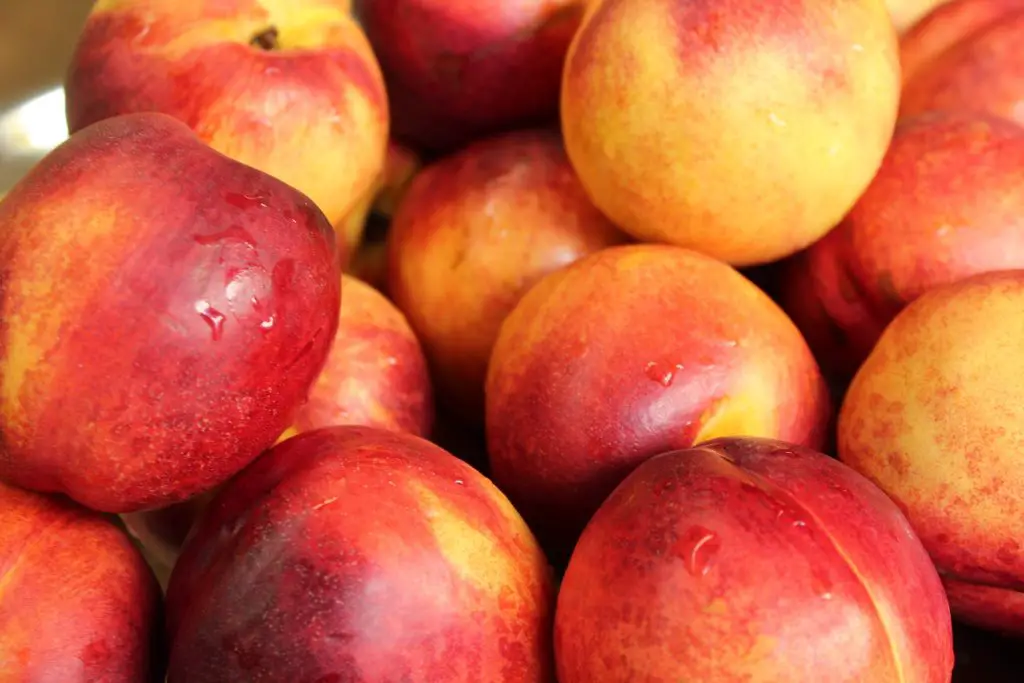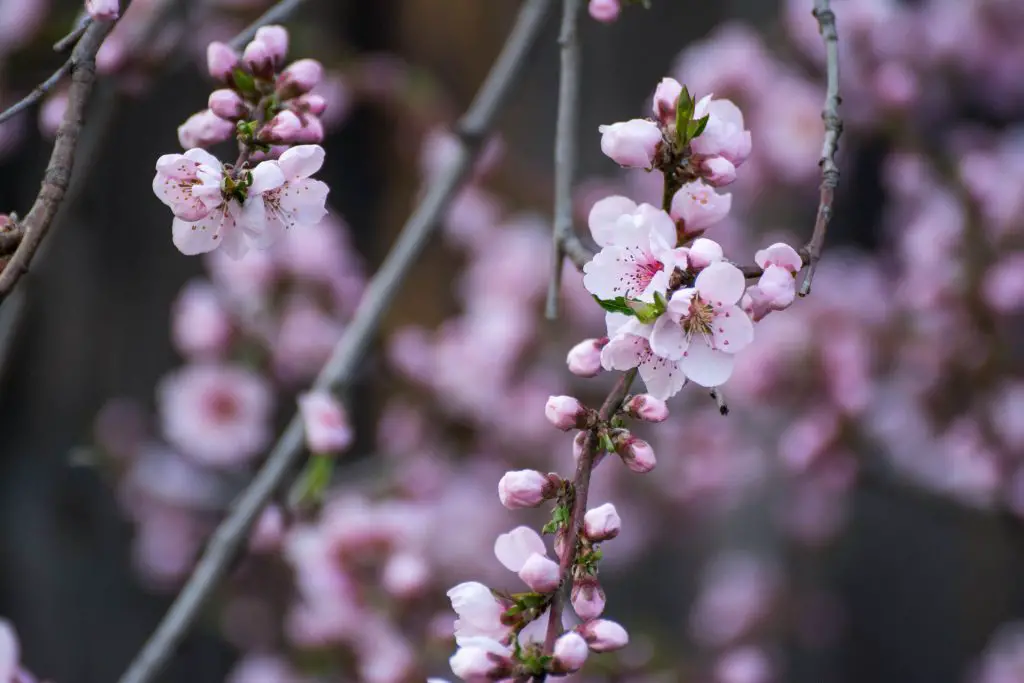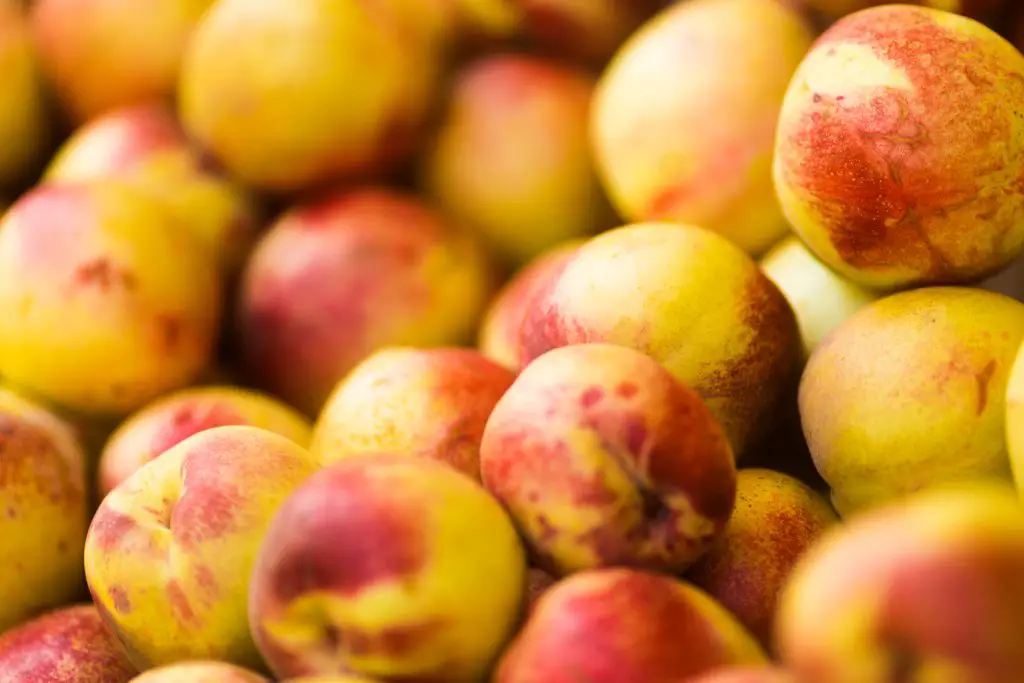How Many Nectarines Does A Tree Produce? Nectarines are a popular variety of Peach that is eaten the world over. While they are sold under a different name they are in fact the same species as the Peach with the primary distinction being the lack of fur on the surface of the fruit.
In terms of output, Nectarine trees are less productive than other stone fruits such as Apricots and Plums. A mature Nectarine tree will produce between 33 lbs and 66 lbs (15 and 30 kg) of fruit according to a study conducted by the University of Idaho. This equates to between 75 to 200 fruit per tree depending on the particular variety selected.
The nectarine harvest typically occurs between June and September depending on the climate and the variety. In cooler climates such as Idaho, in zone 7a, harvests of the earliest varieties start in late July and the latest varieties were harvested in mid to late September. Whereas in warmer climates such as California harvests started in mid-June and the latest varieties were harvested in early July.
Generally, the warmer the climate the early and shorter the fruiting season is, so for those living in zone 6 and 7 selection of cultivar grown will have an appreciable effect on the timing of the harvest. In this climate, it is worth considering planting multiple cultivars in order to increase the harvest period.
A list of the varieties trialed by the University of Idaho along with the harvest date record provides a good indication of some potentially suitable varieties that could be used to extend the fruiting season.
| Variety | Harvest Date |
| Diamond June | 27th July |
| Honey Kist | 30th July |
| Summer Beaut | 7th August |
| Red Diamond | 10th August |
| Diamond Ray | 20th August |
| Supreme Red #1 | 22nd August |
| Summer Grand | 28th August |
| Fantasia | 3rd September |
| Summer Fire | 11th September |
| Sparkling Red | 16th September |

How Long Does It Take For An Nectarine Tree To Fruit?
For a Nectarine tree to reach maturity typically it takes 6 to 8 years with the first harvest available after 3 years, though this does vary between cultivars.
However, the majority of trees sold through garden centers are grafted trees that are two years old. The implication of this is that the average home gardener purchasing a tree will need to wait, one to two years after planting before they see any fruit.
As a rule of thumb after 3 to 4 years, you will typically see around half the yield of a mature tree, 18 lbs and 33 lbs (7.5 and 15 kg) and this will in most cases, increase to the 7 or 8-year mark.
Do You Need To Plant Two Nectarine Trees To Get Fruit?
Nectarine varieties, like Peaches trees, are self-pollinating trees that do not require the presence of a second variety to set fruit. However, like many fruiting plants, Nectarines do have a tendency to produce larger volumes of fruit if there is a second tree nearby.
However, unlike other trees such as Plums and Apples, which require the selection of specific varieties that flower at the same time any second nectarine will serve to improve the quality of the pollination.
The reason for this is because all the varieties of Nectarine irrespective of whether they are early or late fruiting varieties flower at approximately the same time. All the varieties tested in the University of Idaho study all reached full bloom within a few days of each other in all 4 years that the trial was run.

What Are The Best Performing Nectarine Varieties To Grow?
The yield for all the varieties tested by the University of Idaho is provided in the table below. The varieties are ordering from the earliest to the latest harvest. If you live a cooler climate we would recommend planting Honey Kist, Diamond Ray, and Fantasia together. The reason for this is that these varieties are among the highest-yielding trees their harvest dates would allow the fruiting season to be spread over 3 to 4 months.
If you live in a warmer region we would recommend selecting Honey Kist due to its yield. The selection of early, mid and late-season varieties would not provide a great deal of benefit in terms of the timing of the harvest as all the varieties fruit within a few weeks of each other.
| Variety | Yield |
| Diamond June | 13.1 kg (29.5 lbs) |
| Honey Kist | 31.4 kg (69.2 lbs) |
| Summer Beaut | 15.9 kg (35.0 lbs) |
| Red Diamond | 11.4 kg (25.1 lbs) |
| Diamond Ray | 29.4 kg (64.8 lbs) |
| Supreme Red #1 | 10.4 kg (22.9 lbs) |
| Summer Grand | 15.4 kg (34.0 lbs) |
| Fantasia | 24.7 kg (54.5 lbs) |
| Summer Fire | 15.3 kg (33.7 lbs) |
| Sparkling Red | 12.2 kg (26.9 lbs) |
How To Plant Nectarine Trees
Like most stone fruit Nectarine Trees are best planted in late winter or early spring, however, the precise timing of this is dependant the climate in which you live. If you live in a region where the ground freezes in winter it is best to plant the trees a little later in the season.
The other advantage of planting the trees at that time of year is that they can be purchased bare-rooted. Bare-rooted trees are usually around half the price of potted trees. Additionally, it is common for retailers to reduce the price of the bare-rooted trees heavily in early spring to help clear stock.
However, before purchasing a tree it is best to select a location to plant the tree. Like most fruit trees they need to flower in order to produce fruit to optimize this it is best to select a warm sunny location that gets at least 8 hours of sun per day.
The next consideration is the quality of the soil, Nectarine trees generally prefer well-drained soil that is rich with organic matter. Ideally. the soil should be slightly acidic soil, a pH of 6.5 to 7.0 is preferred. To test the soil it is best to use a pH meter because they are easiest to operate than using pH strips and they usually provide a more accurate result. They are also lower in cost than pH kits, click here to see the latest price on Amazon.
To save space you may want to consider espaliering the trees. This is a training technique that I highly recommend because it makes managing the tree easier. For the benefit of those people unfamiliar with Espaliered trees, it is a technique of pruning that maintains the tree in a 2 dimension shape. This shape optimizes fruit produce while minimizing the space required for the tree. To read more about espalier trees click here.

If you are wanting to espalier a tree it is important to put a support structure in place prior to planting to allow it to be trained into the desired shape. If the selected location is against a fence or existing wall it is easiest to hang reinforced concrete mesh on the wall, as it is cheap, strong, and will last a long time.
In most cases, the support structure from an espalier tree is around 6 ft (1.8m) wide and 6 ft (1.8m) tall. This size is best as it allows all the pruning and harvesting of fruit to be done while standing on the ground. It also makes the netting of fruit trees a lot easier to protect the fruit from birds.
Once the site is prepared it is time to plant the tree by digging a hole which should be about 1 ft (30cm) wide. At this point remove the tree from its packaging and position it in the hole. The depth that the tree should be at should be approximately the same depth as it had been previously been in the ground. It is also important to make sure that the graft union of the tree is around 2 inches above the ground.
Once you are happy with the position of the tree back-fill the hole with soil, firming the soil in as you go to ensure that there are no air pockets. Deeply water the plant to ensure that the soil is fully saturated and then apply a thick layer of organic mulch, 2 to 4 inches is ideal. At this stage it is important to make sure that the mulch does not come into contact with the trunk, to avoid collar rot.
If you are planting in winter the tree should be pruned aggressively to reduce the size by around half. Ideally, cut above an outward-facing bud to encourage the formation of a vase-like structure that is open and will allow light and air into the center of the tree.
In the following seasons, any inward-facing branches need to be removed to maintain the desired shape. You will also need to reduce the height of the tree aggressively, to do this it is best to cut 1 to 2 ft (30 to 60 cm) above forks in branches to encourage the tree to continue to develop a vase-like structure.
For those trees that are being espaliered the pruning regime is slightly different. Start by tying any branches to the support structure and remove any branches that cannot be tied in. This may be required to be done a few times during the growing season to maintain the desired shape.
